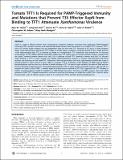Tomato TFT1 Is Required for PAMP-Triggered Immunity and Mutations that Prevent T3S Effector XopN from Binding to TFT1 Attenuate Xanthomonas Virulence
Author(s)
Aakre, Christopher David; Taylor, Kyle W.; Kim, Jung-Gun; Su, Xue B.; Roden, Julie A.; Adams, Christopher M.; Mudgett, Mary Beth; ... Show more Show less
DownloadTaylor-2012-Tomato TFT1 is requi.pdf (2.243Mb)
PUBLISHER_CC
Publisher with Creative Commons License
Creative Commons Attribution
Terms of use
Metadata
Show full item recordAbstract
XopN is a type III effector protein from Xanthomonas campestris pathovar vesicatoria that suppresses PAMP-triggered immunity (PTI) in tomato. Previous work reported that XopN interacts with the tomato 14-3-3 isoform TFT1; however, TFT1's role in PTI and/or XopN virulence was not determined. Here we show that TFT1 functions in PTI and is a XopN virulence target. Virus-induced gene silencing of TFT1 mRNA in tomato leaves resulted in increased growth of Xcv ΔxopN and Xcv ΔhrpF demonstrating that TFT1 is required to inhibit Xcv multiplication. TFT1 expression was required for Xcv-induced accumulation of PTI5, GRAS4, WRKY28, and LRR22 mRNAs, four PTI marker genes in tomato. Deletion analysis revealed that the XopN C-terminal domain (amino acids 344–733) is sufficient to bind TFT1. Removal of amino acids 605–733 disrupts XopN binding to TFT1 in plant extracts and inhibits XopN-dependent virulence in tomato, demonstrating that these residues are necessary for the XopN/TFT1 interaction. Phos-tag gel analysis and mass spectrometry showed that XopN is phosphorylated in plant extracts at serine 688 in a putative 14-3-3 recognition motif. Mutation of S688 reduced XopN's phosphorylation state but was not sufficient to inhibit binding to TFT1 or reduce XopN virulence. Mutation of S688 and two leucines (L64,L65) in XopN, however, eliminated XopN binding to TFT1 in plant extracts and XopN virulence. L64 and L65 are required for XopN to bind TARK1, a tomato atypical receptor kinase required for PTI. This suggested that TFT1 binding to XopN's C-terminal domain might be stabilized via TARK1/XopN interaction. Pull-down and BiFC analyses show that XopN promotes TARK1/TFT1 complex formation in vitro and in planta by functioning as a molecular scaffold. This is the first report showing that a type III effector targets a host 14-3-3 involved in PTI to promote bacterial pathogenesis.
Date issued
2012-06Department
Massachusetts Institute of Technology. Department of Biology; Massachusetts Institute of Technology. School of ScienceJournal
PLoS Pathogens
Publisher
Public Library of Science
Citation
Taylor, Kyle W. et al. “Tomato TFT1 Is Required for PAMP-Triggered Immunity and Mutations That Prevent T3S Effector XopN from Binding to TFT1 Attenuate Xanthomonas Virulence.” Ed. Shengyang He. PLoS Pathogens 8.6 (2012).
Version: Final published version
ISSN
1553-7366
1553-7374